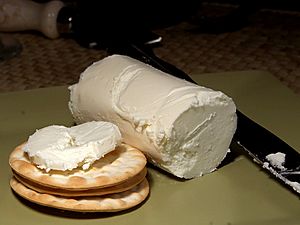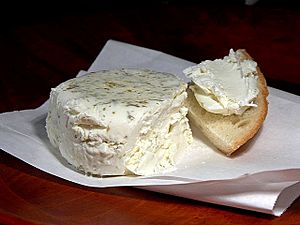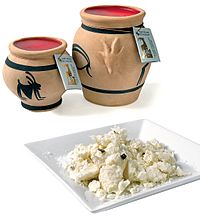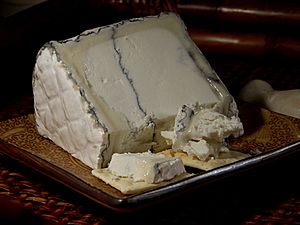Goat cheese facts for kids
Goat cheese, or chèvre (/ˈʃɛvrə/ or /ˈʃɛv/; from French fromage de chèvre 'goat cheese'), is cheese made from goat's milk. Goats were among the first animals to be domesticated for producing food. Goat cheese is made around the world with a variety of recipes, giving many different styles of cheese, from fresh and soft to aged and hard.
Contents
Properties
History
Goats produce high quality, nutrition-rich milk under even the most difficult environments making them valuable to arid or mountainous areas where cows and sheep can not survive. Goats were one of the earliest animals domesticated to suit human needs- more specifically milk production- going back to 8,000 B.C., 10,000 years ago. Goat cheese has been made for at least as far back as 5,000 B.C. Meanwhile, the first documented proof of humans making cheese is 7,500 years ago in Poland.
Nutritional value
Goat milk has a higher proportion of medium-chain fatty acids such as caproic and caprylic which contributes to the characteristic tart flavor of the cheese. It also makes goat milk and cheeses more easily digestible.
Goat milk and, therefore, cheeses contain anti-inflammatory enzymes, probiotics, antioxidants, proteins, and lipids and help maintain a healthy metabolism. These fatty acids take their name from the Latin for "goat": capra. It is also high in calcium, vitamins A and K, phosphororus, thiamin and niacin.
Process
Goat cheese is made like other cheeses. The milk is filtered to remove unwanted bacteria or deposits. A curdling starter agent is added, which can be rennet, or one or more starter bacteria that will affect the curds' size and eventually the cheese's consistency. Some examples of starters are Lactococcus Lactis, Lactis, Lactococcus Lactis subsp. cremoris, and Streptococcus thermophilus. Next, the cheese is molded and separated from the whey (the uncurdled liquid part of the milk). The curds are then molded, dried, flavored and cured. Any variations- the type of starter, the time or pressure of the draining, the temperature and duration of the curing process- will change the texture (soft, semi-hard, hard) and the flavor.
Regional varieties
Asia
China
- Rubing is a fresh goat cheese from Yunnan Province, resembling the Indian paneer, a cow's cheese.
- Shosha – a pungent cheese and staple food in Tibetan cuisine of the Tibet Autonomous Region that is often made from animals suited to the climate such as goat and yak.
Japan
- Yagi Cheese is a goat cheese made in Japan. Yagi is the Japanese word for goat.
Middle East
- Darfyieh is a flavorful cheese that comes specifically from baladi goats and is treated as a delicacy in Dargyieh.
- Djamid or Jameed is an unripened, hard cheese with a salt encrusted rind popular in Jordan and Syria.
- Labneh is consumed in many parts of the world. It is primarily produced in Egypt, Lebanon, Syria, Palestine and Jordan but also throughout much of the Middle-east. It can be served with olive-oil, or seasoned with mint, eaten with salad or as dessert.
Europe
France
France produces a great number of goat milk cheeses, especially in the Loire Valley and Poitou.
- Chevre is a soft, creamy, melt-in-mouth cheese that can have a fruity taste to it. It is usually covered in a light colored rind or skin. It is not aged for very long. It is sometimes served hot as chèvre chaud.
- Bucheron, Chabis, Chavroux, Clochette, Couronne Lochoise, Crottin de Chavignol, Faisselle, Montrachet (Burgundy), Pélardon, Picodon, Pouligny Saint-Pierre, Rocamadour, Sainte-Maure de Touraine, Chabichou du Poitou, Valençay, and Pyramide.
Greece
- Feta is made primarily of ewe's milk, with up to 30% of goat milk.
- Mizithra is a whey cheese which can produced from the whey left over from goat cheeses. It is served either fresh or dried.
- Anthotyros is a whey cheese using the whey from Kefalotyri or Graviera production and can be made from milk from goats, sheep or a combination. It is served fresh or dried.
Italy
- Caprino is a term encompassing at least 33 different goat milk cheeses produced in Italy, equivalent to the French chèvre
- Acidino (tr. slightly acid), produced in Veneto
- Agrì di Valtorta, produced in Lombardy
- Formaggio di capra di Lagundo (or Algunder Ziegenkäse), produced in South Tyrol
- Canestrato di Moliterno Stagionato in Fondaco, produced mixing sheep and goat milk in Apulia and Basilicata
- Cavrin (or Cevrin) di Coazze, produced in Piedmont
- Ircano, produced in Sardinia
- Salignon, a smoked cheese produced in the lower Aosta Valley
- Ricotta is produced from the whey that from cheesemaking. Ricotta means 're-cooked', and is made by reheating the whey, until the clotted cheese curds rise to the top, where they are skimmed and molded.
Malta
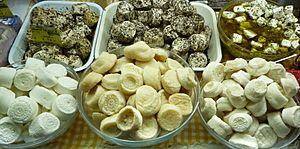
- A ġbejna is a small goat's- or sheep's-milk cheese. Various types are found which include; fresh (friski or tal-ilma), sundried (moxxa, bajda or ta' Għawdex), salt cured (maħsula), peppered (tal-bżar) and seasoned (imħawra).
Netherlands
- The Westerkwartier, the region west of the city of Groningen, has a relatively large concentration of organic goat-cheese farms. Well known goat cheeses from this region are Machedoux and Quiorio, brie-like cheeses served in restaurants all over the Netherlands and in Belgium and northern Germany. In other parts of the Netherlands, goat cheese is usually made in the Gouda style.
Norway
- Geitost, which means goat cheese, is brown and made from goat milk and whey. Other brown cheeses, such as Brunost ("Brown cheese"), may also be made from cow milk whey, goat milk whey or a combination.
- Snøfrisk is a fresh goat milk cheese, often made with added flavorings.
Portugal
- Castelo Branco is a Portuguese goat milk cheese.
- Trás-os-Montes is a goat milk cheese from Alto Trás-os-Montes, Norte Region, Portugal.
Spain
- Mató is a Catalan fresh cheese made from cow's or goat's milk.
- Garrotxa is a firm goat cheese originally from Garrotxa in northern Catalonia.
- Nevat, a soft-ripened goat cheese from Catalonia.
- Majorero cheese is a goat milk cheese from the Canary Island of Fuerteventura.
Turkey
- Tulum cheese is a goat cheese made in Turkey.
- Sepet cheese and Kaşar cheese are produced from goat milk and marketed as Goat Sepet cheese and Goat Kaşar cheese.
- Beyaz peynir 'white cheese' is a brined cheese produced from sheep, cow, or goat milk.
- Ezine Cheese, originating from Ezine, Çanakkale, is a type of Beyaz Peynir including at least 40% goat milk according to the geographical protection rules.
United Kingdom
- Pantysgawn is a Welsh goat milk cheese.
- Capricorn is a Somerset goat milk cheese.
Americas
United States
- Kunik is produced at Nettle Meadow Goat Farm in Thurman, New York, and made from goat and Jersey cow milk blend, mold-ripened with similar properties to Brie.
- Humboldt Fog is a mold-ripened goat cheese with a central line of edible white ash made in California by Cypress Grove Chevre.
Venezuela
- In Venezuela, specifically in the states of Falcón, Lara and the population of San Jose de Turgua in Miranda state, many types of goat cheese are produced using traditional methods. A variety of artisanal cheeses are manufactured by smaller producers.
See also
 In Spanish: Queso de cabra para niños
In Spanish: Queso de cabra para niños


